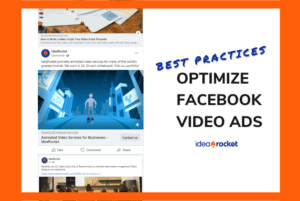Customer testimonial videos are a must for companies today. When a happy customer tells their story, they’re showing that your product or service works, and it can work for others, too. Customer testimonials are authentic, relatable, and a powerful storytelling medium.
The research shows it, too. Buyers today typically head to the reviews section, and according to a study from Software Advice, 75 percent of buyers rely on peer reviews when evaluating products.
Customer testimonials go beyond the sales pitch by providing a real-life example of success in action, told from the perspective of a person that’s just like your audience. It’s no longer selling — it’s real life.
Here’s what to consider when creating the right customer testimonial video for your company:
Types of Customer Testimonial Videos
Client Testimonial Interviews: Client testimonial interviews are typically shorter, and focus on one (or several) company representatives. Client testimonial interviews can be used as standalone assets. Or, you can stitch several interviews together, along with some b-roll, to create a long-form client case study.
Here’s an example from a partnership between Zendesk and Zoom, a meeting management platform. The video uses a blend of in-office shots and client interviews to tell a complete customer story.
Customer Case Studies: Customer case study videos typically focus on a specific event or campaign where you and your client worked together to find success. This style is more focused on telling a story, with a clear narrative and sequence.
Take a look at how Memorial Sloan Kettering uses a blend of imagery, interview, and narrative to tell a powerful patient story:
Choosing The Right Customer Partner
Not all your clients are going to be the best fit for getting in front of a camera. Here’s what to consider:
Customer Relationships
You want to work with a client that has a strong relationship with your brand. These partners are more likely to speak with knowledge and authenticity when promoting your product or service. Clients who have a strong relationship with your company are also more likely to advocate for you if there is a tough approval process on their end.
“So many companies do not want to go on record supporting a vendor,” Don Forschmidt, a video director for IdeaRocket, said. “If it is more personal, it’s less of an issue.”
Look for customers who have success stories with a clear narrative you can present to viewers or potential prospects. Back the narrative up with data to demonstrate the benefits in an easy-to-understand way.
Approvals
This is the toughest hurdle when getting a client on board. Some companies, especially larger brands, or brands in sensitive industries (like healthcare or finance), may require several rounds of approvals or legal review before giving the green light on a video project. Work with your client partner to lay out the ground rules, so you can create a video that adheres to their needs, and you don’t end up filming something that can’t be used.
Promotion And Fit
Video testimonials are an opportunity for both you and your client to showcase the work you do. When choosing a client, consider how the video can help both parties, and the audience you’re trying to reach. Companies or executives that are industry leaders have a larger influence — their voices on camera could draw more viewership, and help boost cross-promotional initiatives.
Shared Incentives
If you’re having trouble getting a client on board, “sweeten the deal” by showing how their participation will benefit them. Cross-promotion can help expose their brand to your audience, by a dedicated placement in your newsletter, on your website, and through social media channels. You can also negotiate monetary deals, like a discount on your service, or branding at your next event. Another possibility is capturing some video for them; since you have a film crew at their office with lighting and sound set up, it will be practically free to capture some talking heads footage that they can use for their own promotional purposes.
Casting Customer Testimonial Videos
Make sure the customer representatives you’re interviewing are comfortable on camera, and are prepared well ahead of the shoot. Before the interview, be sure to send over all materials they would need, including:
- A breakdown or storyboard of the video
- Interview questions
- Suggested attire/hair/makeup for the shoot (if applicable)
- How long the shoot will take, and if they will be needed in any b-roll shots outside of the interview
You may even want to do a rehearsal run of the interview before the day of the shoot, so the interviewer can practice their responses. Also, aim for interview responses that are short and sweet (30 seconds or less) that can be edited into the soundbites you need.
Finding The Right Location
According to Forschmidt, the first thing you need to is make sure your client is aware of how much space you’ll need to shoot your video, and how long the shoot will take.
“Always communicate how many crew members and others are coming in and how much equipment,” Forschmidt said. “People are amazed when they see how much equipment it takes.”
Once you know how big your crew is, and how much equipment you need, work on finding space that fits, whether it’s in your office, their office, or on location.
“First thing is usually is the room large enough to shoot in. With camera, lights, grip equipment, the interviewers, and possibly other onlookers, it can get tight. If it is large enough, it is always good to have access to another room to hold cases and extra equipment out of the way. You often don’t want to be spilling out into a hallway with equipment,” Forschmidt said.
During a shoot, production crews may need to move things around in the office in order to get the shots they need. This could leave the space in disarray, so be sure to clean up before you go.
“Make sure you take photos of the space so you can restore it exactly when you leave,” Forschmidt said. “Always leave a location in better shape than when you got there. Good rule of thumb for all production.”
Lighting
You want your interview to look great — and the right lighting makes a huge difference.
“Sometimes this can be helpful to supplement what you are going to do, but it can sometimes be a battle if strong light is pouring in, causing a harsh streak across the background,” Forschmidt said. “ It’s good to know if there are windows, if are there blinds [to monitor light], and what direction are the windows facing”
Sound
Background noise can drown out the interview, and add hours to post-production if you have to edit out unexpected sound. When looking for a place to shoot, Forschmidt says the quieter, the better.
“Find out if there is a lot of noise around the office and can it be controlled, “Forschmidt said. “Make sure people near your subjects office are aware that a bit more quiet might be needed, so avoid yelling, and using speaker phones in the next office.”
Testimonial Video Editing And Post-Production
You’re going to leave your video shoot with a ton of b-roll and interview footage. In post-production, consider:
Interviews: Chances are, you’re not going to use all your interviews in full. Only pull the best soundbites, and piece them together to help tell the right story
B-Roll: Once you have your soundbites, choose the b-roll that makes the most sense with your story.
Text Overlays: Add in the name and title of your interviewees in the lower third. Also, consider additional graphics and branding that adds to the video.
Captions and Transcriptions: Make sure you transcribe your video and add in captions.
Thumbnails and Video Title: Your video thumbnail and title is the first thing a viewer sees before clicking in. Make sure you choose ones that are engaging.
Promoting Your Customer Testimonial Videos
Now that your video is done, it’s time to promote it! Maximize the reach of your video by:
- Putting it on your website in a place that makes sense – perhaps near your client roster, or immediately before your call-to-action.
- Promoting across all your channels (email, website, social media, etc.)
- If you have a series of video create a dedicated YouTube channel or page on your website where they can be easily accessed.
- Use the video in sales calls or at trade show events
- Repurpose your video in blog posts or in campaigns
- Cross-promote the video on your customer’s channels
Conclusion
Customer testimonials can showcase a whole different side of your brand, and establish you as a trusted leader in your industry, with demonstrable results. Customer voices are more relatable, and give a real-life look at what it’s like to use your product or service. You’re also promoting the great work your clients are doing, so it’s a win-win!
Want to learn more about how IdeaRocket can help? Drop us a line here.




